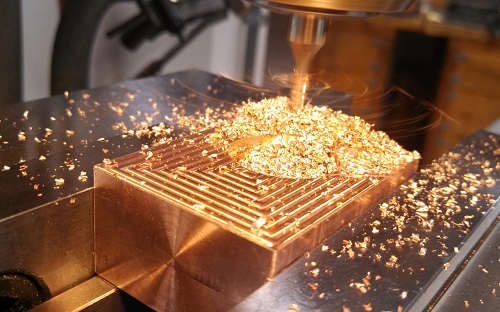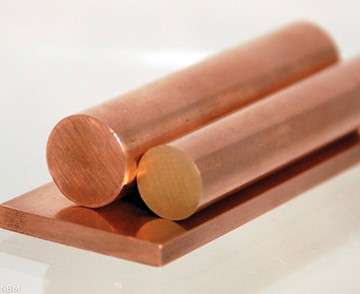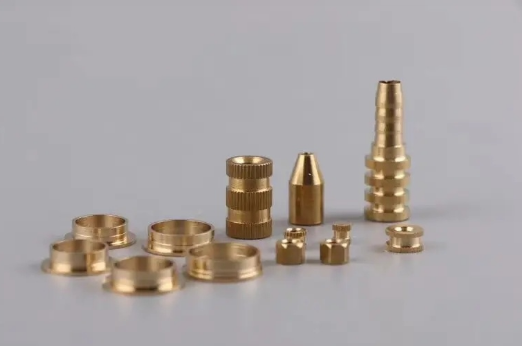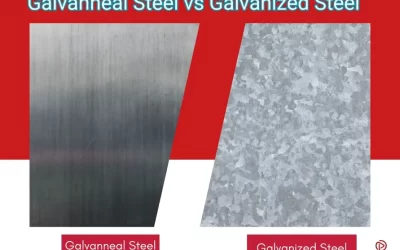The availability of ore, low melting point, and ductility of copper make it a popular and widespread material. It has a number of valuable properties: malleability, high level of thermal conductivity, electrical conductivity, and strength. Therefore, copper is often included in the design of electrical engineering, and is popular in modern production.
What is CNC Copper Machining?
One of the most precise metal processing services for producing copper parts in a variety of sectors is CNC copper processing. Copper is a good conductor of heat and electricity. It is the ideal option for CNC machining because of these qualities. Automobile, aerospace, medical, and other industries employ copper components that have undergone CNC processing.
This article provides a comprehensive introduction to CNC copper processing, including its uses and numerous considerations. You can select the best copper alloy based on your design requirements as long as you are aware of the traits, benefits, and drawbacks of each alloy.

CNC Copper Machining
Characteristics of Copper and Its Alloys
One of the earliest materials utilized to make pieces is copper. It is a good option for CNC machining because of these qualities.
Automotive, aerospace and medical industries all use CNC-machined copper components. One of the simplest materials to the machine is copper, which enables machinists to fully take advantage of the material’s characteristics.
More resources:
CNC Machining for Automotive Industry: Applications and Advantages
Common Copper Grades and Copper Alloys That Are CNC Machined
Some of the most widely used copper grades for CNC machining include the following:

Copper Grades
Copper 101: The purest grade of copper, Copper 101, contains 99.9% copper. For alloys like bronze and brass, it acts as the foundation. Coaxial cables, bus bars, and waveguides all make use of copper 101 supports.
Bronze: The strength and hardness of this alloy of tin, copper, and phosphorus are well known. Bearings and gears are made from bronze using CNC machining.
Brass: This zinc and copper alloy is renowned for being both workable and tough. Valves, gears, bearings, and locks are just a few examples of the sophisticated and low-friction pieces that brass is machined into. Brass components may be exposed to saltwater and other contaminants when utilized in outdoor applications.
A few typical advantages of using copper or copper alloy items are listed below:
- High ductility,
- High heat conductivity,
- Easy solderability,
- High corrosion resistance
- High alloy machinability
The machinability of copper alloys is determined by the temperature in the cutting zone and the abrasion ability of the alloy:
1) Additive to copper of any element that forms a solid solution with it (tin, aluminum, silicon) reduces V T by 3-4 times due to a sharp decrease in the thermal conductivity of the material and an increase in cutting temperature by 1.6…2 time
2) The addition of nickel to the copper alloy, which completely dissolves in copper and does not create a new phase, has little effect on V T;
3) The transition from homogeneous to heterogeneous structures leads to a decrease in V T by almost half due to the abrasive action of solid particles of the eutectoid. The cutting temperature changes slightly;
4) The creation of new phases in heterogeneous alloys has practically no effect on machinability. The exception is lead additives, which, by reducing the abrasive ability of the material and reducing cutting temperatures contribute to a significant increase in V T.
The above patterns allow you to arrange copper alloys in a certain way according to their machinability. When processing copper alloys with K M = 1 V T 2 … 3 times higher than when processing cast irons and steels.
The machinability of copper alloys deteriorates sharply in the presence of slag inclusions, as well as microcracks and other casting defects.
Common CNC Copper Machining Applications

CNC Copper Applications
Electrical, construction, transportation, and consumer goods businesses all use copper CNC components.
- It is primarily utilized when hard materials are being sheared or flame cut.
- It is used in companies that remove metal, where raw materials are removed in order to achieve high precision levels.
- To produce motor parts like gears or shafts, the automotive industries also use CNC machining of copper.
- They are also utilized by businesses that produce goods that are round, rectangular, or square and are of the greatest quality.
- CNC machining copper is used in sectors that create durable thin steel plates.
- It is used to produce sturdy steel sheets in the fabrication industry.
- The electrical discharge machining industry uses CNC machining copper to produce sparks.
Processing Features
Due to its ductility, copper is well-processed by forging and stamping. This property predetermined the increase in the volume of extraction and use of this material during the Bronze Age. Today, copper is easily processed on CNC milling machines.
However, to get a quality product, you need to work following certain rules. Since copper has a high ductility, the cutter may “get stuck” in the product during processing. To have good performance, you need:
- Use a cutting tool made of hard alloys;
- The cutter must always be sharp;
- Compliance with the required spindle speed. With an increase in speed, you can damage the material, cutter, machine;
- Use coolant during work;
- Remove shavings promptly.
Incorrect calculations and selection of parameters can cause severe vibration, as well as equipment imbalance. This will reduce processing accuracy. As a result, in addition to obtaining an irregularly shaped part, the risk of machine failure increases.
Turning is one of the most common types of metalworking. It is produced by cutting a thin layer of metal, resulting in a part of a certain size and shape.
The Optimal Conditions for CNC Copper Machining
The optimal cutting conditions for copper are selected specifically for the current processing conditions and machine model. The main criteria in this case are:
1. Tool feed speed from 4 to 6 mm/s
2. Depth of copper cutting is not more than 30% of the tool diameter
3. Low spindle speed (an increase in processing speed is only allowed when using carbide cutters)
Some Important Tips During CNC Copper Machining
This material is well suited for machining, but when working with it on CNC machines, some rules must be strictly observed. Such an advantage of copper is ductility – during milling, it affects the increased formation of sticky chips. And this requires:
1. Use a carbide-cutting tool
2. Keep the cutter sharp and the chip groove clean
3. Optimum material feed and spindle speed
4. Use coolant
5. Ensure that chips are quickly and cleanly evacuated from the cutting area
The best choice in most cases for working with copper is carbide cutters with a chip breaker.
Please note that copper processing is most often carried out at low speeds, the temperature in the cutting zone is low, and this dictates the need for a mandatory lubrication and cooling system on the machine.
Summary
When working with copper, special attention should be paid to the control program of the CNC machine. Use the most advanced programs – CAM-environment, ArtCam, MasterCam SolidCam, etc., guaranteeing maximum smoothness of movement and uniform speed of the cutter.
Such programs, by the way, allow you to calculate in advance the required time to complete specific copper processing processes, and you can “on the go” adjust this time by changing various parameters and cutting conditions.
At Prolean our CNC experts have many years of experience in the field of CNC machining. In this way, the lead time and the quality of parts can be guaranteed. If you are interested in machining any of your drawings, please feel free to contact us, and we will get your production plan and quote in a few hours.




0 Comments